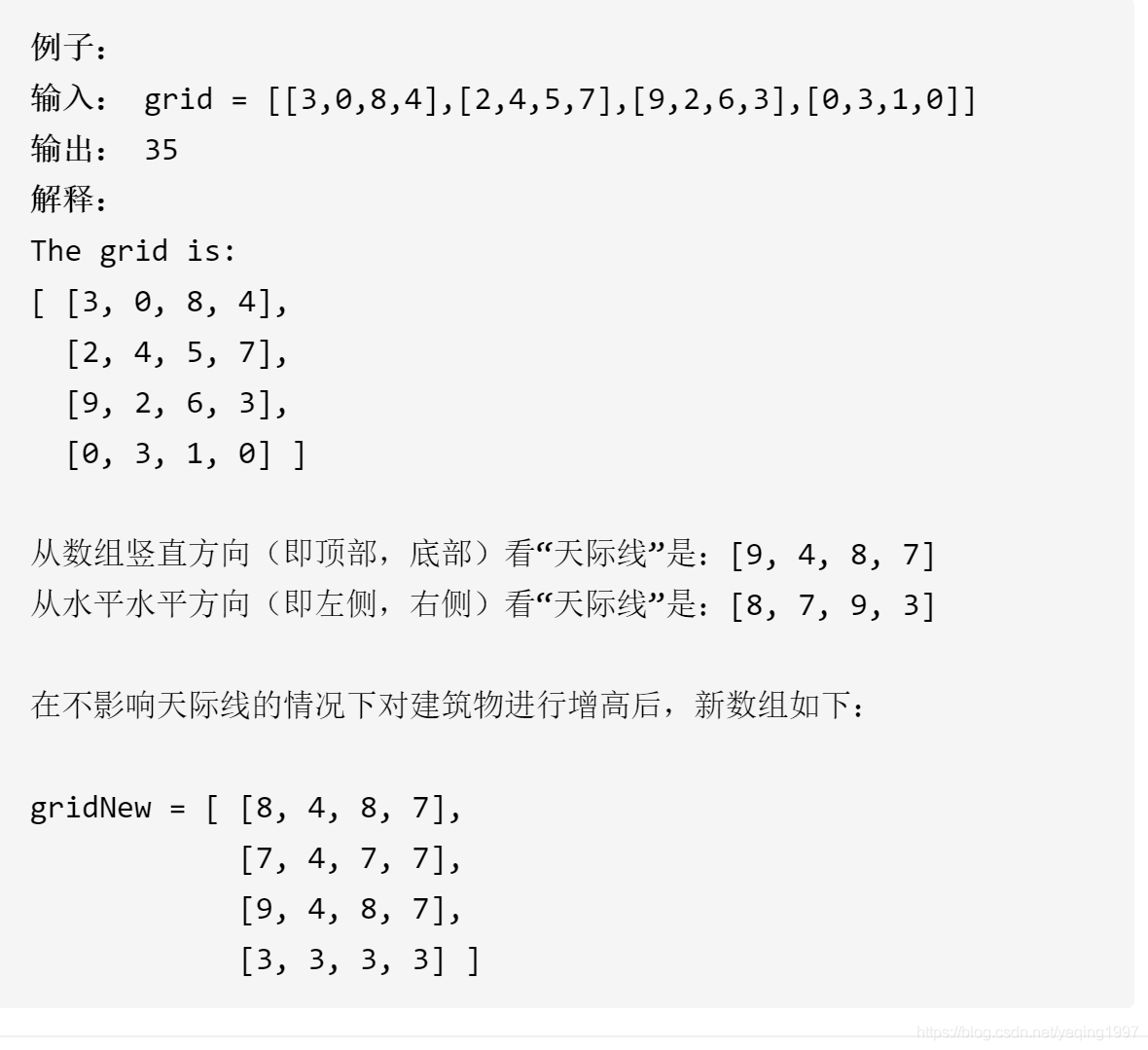807
题目描述:
在二维数组grid中,grid[i][j]代表位于某处的建筑物的高度。 我们被允许增加任何数量(不同建筑物的数量可能不同)的建筑物的高度。 高度 0 也被认为是建筑物。
最后,从新数组的所有四个方向(即顶部,底部,左侧和右侧)观看的“天际线”必须与原始数组的天际线相同。 城市的天际线是从远处观看时,由所有建筑物形成的矩形的外部轮廓。 请看下面的例子。
建筑物高度可以增加的最大总和是多少?
示例:

解答:
class Solution:
def maxIncreaseKeepingSkyline(self, grid: List[List[int]]) -> int:
'''
zip() 函数用于将可迭代的对象作为参数,将对象中对应的元素打包成一个个元组,
然后返回由这些元组组成的列表。
如果各个迭代器的元素个数不一致,则返回列表长度与最短的对象相同,
利用 * 号操作符,可以将元组解压为列表。
'''
row=[max(r) for r in grid]
col=[max(c) for c in zip(*grid)]
ans=0
lr,lc=len(grid),len(grid[0])
for i in range(lr):
for j in range(lc):
ans+=min(row[i]-grid[i][j],col[j]-grid[i][j])
return ans
1232
题目描述:
在一个 XY 坐标系中有一些点,我们用数组 coordinates 来分别记录它们的坐标,其中 coordinates[i] = [x, y] 表示横坐标为 x、纵坐标为 y 的点。
请你来判断,这些点是否在该坐标系中属于同一条直线上,是则返回 true,否则请返回 false。
示例:

解答:
class Solution:
def checkStraightLine(self, coordinates: List[List[int]]) -> bool:
dx = coordinates[1][0] - coordinates[0][0]
dy = coordinates[1][1] - coordinates[0][1]
for x, y in coordinates[2:]:
if dx * (y - coordinates[0][1]) != dy * (x - coordinates[0][0]):
return False
return True
1379
题目描述:
给你两棵二叉树,原始树 original 和克隆树 cloned,以及一个位于原始树 original 中的目标节点 target。
其中,克隆树 cloned 是原始树 original 的一个 副本 。
请找出在树 cloned 中,与 target 相同 的节点,并返回对该节点的引用(在 C/C++ 等有指针的语言中返回 节点指针,其他语言返回节点本身)。
示例:

解答:
# Definition for a binary tree node.
# class TreeNode:
# def __init__(self, x):
# self.val = x
# self.left = None
# self.right = None
class Solution:
def getTargetCopy(self, original: TreeNode, cloned: TreeNode, target: TreeNode) -> TreeNode:
if not original:
return None
if original==target:
return cloned
return self.getTargetCopy(original.left,cloned.left,target) or self.getTargetCopy(original.right,cloned.right,target)
1476
题目描述:
请你实现一个类 SubrectangleQueries ,它的构造函数的参数是一个 rows x cols 的矩形(这里用整数矩阵表示),并支持以下两种操作:
- updateSubrectangle(int row1, int col1, int row2, int col2, int newValue)
用 newValue 更新以 (row1,col1) 为左上角且以 (row2,col2) 为右下角的子矩形。 - getValue(int row, int col)
返回矩形中坐标 (row,col) 的当前值。
示例:
输入:
[“SubrectangleQueries”,“getValue”,“updateSubrectangle”,“getValue”,“getValue”,“updateSubrectangle”,“getValue”,“getValue”]
[[[[1,2,1],[4,3,4],[3,2,1],[1,1,1]]],[0,2],[0,0,3,2,5],[0,2],[3,1],[3,0,3,2,10],[3,1],[0,2]]
输出:
[null,1,null,5,5,null,10,5]
解释:
SubrectangleQueries subrectangleQueries = new SubrectangleQueries([[1,2,1],[4,3,4],[3,2,1],[1,1,1]]);
// 初始的 (4x3) 矩形如下:
// 1 2 1
// 4 3 4
// 3 2 1
// 1 1 1
subrectangleQueries.getValue(0, 2); // 返回 1
subrectangleQueries.updateSubrectangle(0, 0, 3, 2, 5);
// 此次更新后矩形变为:
// 5 5 5
// 5 5 5
// 5 5 5
// 5 5 5
subrectangleQueries.getValue(0, 2); // 返回 5
subrectangleQueries.getValue(3, 1); // 返回 5
subrectangleQueries.updateSubrectangle(3, 0, 3, 2, 10);
// 此次更新后矩形变为:
// 5 5 5
// 5 5 5
// 5 5 5
// 10 10 10
subrectangleQueries.getValue(3, 1); // 返回 10
subrectangleQueries.getValue(0, 2); // 返回 5
示例2:
输入:
[“SubrectangleQueries”,“getValue”,“updateSubrectangle”,“getValue”,“getValue”,“updateSubrectangle”,“getValue”]
[[[[1,1,1],[2,2,2],[3,3,3]]],[0,0],[0,0,2,2,100],[0,0],[2,2],[1,1,2,2,20],[2,2]]
输出:
[null,1,null,100,100,null,20]
解释:
SubrectangleQueries subrectangleQueries = new SubrectangleQueries([[1,1,1],[2,2,2],[3,3,3]]);
subrectangleQueries.getValue(0, 0); // 返回 1
subrectangleQueries.updateSubrectangle(0, 0, 2, 2, 100);
subrectangleQueries.getValue(0, 0); // 返回 100
subrectangleQueries.getValue(2, 2); // 返回 100
subrectangleQueries.updateSubrectangle(1, 1, 2, 2, 20);
subrectangleQueries.getValue(2, 2); // 返回 20
解答:
class SubrectangleQueries:
def __init__(self, rectangle: List[List[int]]):
m=len(rectangle)
n=len(rectangle[0])
self.count=[[rectangle[i][j] for j in range(n)] for i in range(m)]
def updateSubrectangle(self, row1: int, col1: int, row2: int, col2: int, newValue: int) -> None:
for i in range(row1,row2+1):
for j in range(col1,col2+1):
self.count[i][j]=newValue
def getValue(self, row: int, col: int) -> int:
return self.count[row][col]
# Your SubrectangleQueries object will be instantiated and called as such:
# obj = SubrectangleQueries(rectangle)
# obj.updateSubrectangle(row1,col1,row2,col2,newValue)
# param_2 = obj.getValue(row,col)
1614
题目描述:
如果字符串满足以下条件之一,则可以称之为 有效括号字符串(valid parentheses string,可以简写为 VPS):
字符串是一个空字符串 “”,或者是一个不为 “(” 或 “)” 的单字符。
字符串可以写为 AB(A 与 B 字符串连接),其中 A 和 B 都是 有效括号字符串 。
字符串可以写为 (A),其中 A 是一个 有效括号字符串 。
类似地,可以定义任何有效括号字符串 S 的 嵌套深度 depth(S):
depth("") = 0
depth© = 0,其中 C 是单个字符的字符串,且该字符不是 “(” 或者 “)”
depth(A + B) = max(depth(A), depth(B)),其中 A 和 B 都是 有效括号字符串
depth("(" + A + “)”) = 1 + depth(A),其中 A 是一个 有效括号字符串
例如:""、"()()"、"()(()())" 都是 有效括号字符串(嵌套深度分别为 0、1、2),而 “)(” 、"(()" 都不是 有效括号字符串 。
给你一个 有效括号字符串 s,返回该字符串的 s 嵌套深度 。
示例:

解答:
class Solution:
def maxDepth(self, s: str) -> int:
ret=0
depth=0
for c in s:
if c=='(':
depth+=1
ret=max(ret,depth)
elif c==')':
depth-=1
return ret